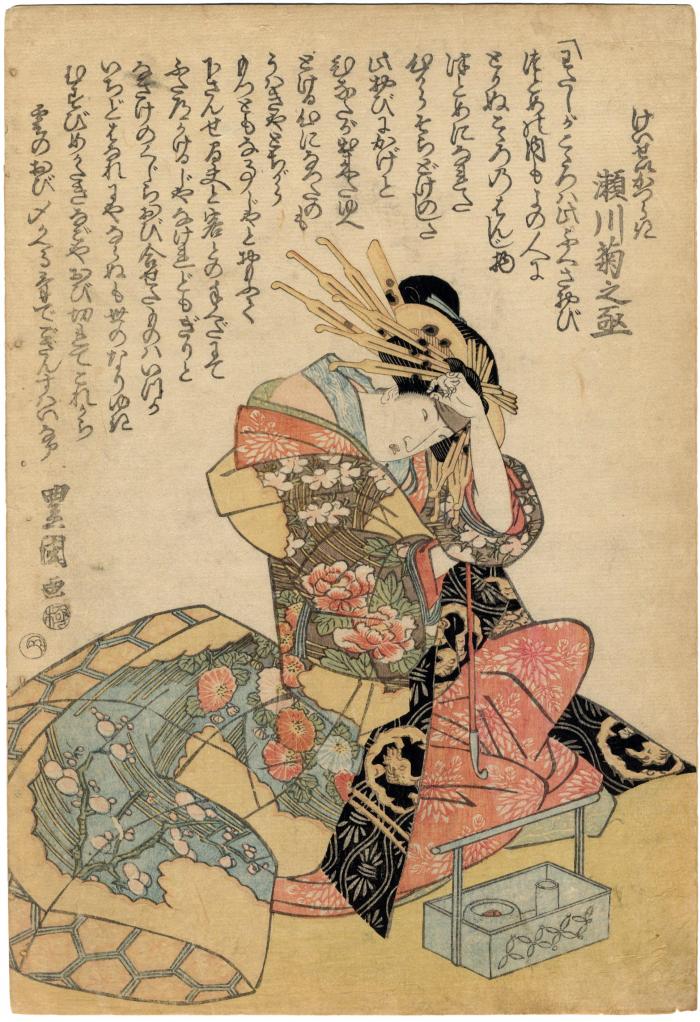Utagawa Toyokuni I (初代歌川豊国) (artist 1769 – 02/24/1825)
Segawa Kikunojō V (瀬川菊之亟) as the keisei Katsuragi (けいせいかつらき)
03/1825
9.5 in x 14 in (Overall dimensions) Japanese woodblock print
Signed: Toyokuni ga (豊国画)
Publisher: Chōjiya Kichi (Marks 028 - seal 08-012)
Censor's seal: kiwame
British Museum - Sharaku showing Katsuragi with a pipe
Museum of Fine Arts, Boston - Kunisada of Katsuragi also with a pipe Lord Keinosuke has two retainers, Fuwa Banzaemon and Nagoya Sanza, he often relies on. He seems to favor Sanza for the more important tasks and this causes a great deal of resentment in Banzaemon who schemes to hurt his rival. Keinosuke has decided to send an important scroll to a temple and asks Sanza to carry it there.
Sanza is in love with the beautiful maiden Iwahashi, so Banzaemon tries to come between them. He approaches Iwahashi as she is returning from her bath, but she eludes him, but loses a sandal in the process. Banzaemon then has the important scroll taken from its box and replaces it with Iwahashi's sandal. When Lord Keinosuke goes to look at the scroll one last time he finds the sandal in its place and furious accuses Sanza of theft in front of the entire court. Iwahashi stands up and admits that it is her sandal, but this does not help either her or her lover. They are both banished from the castle. Even Banzaemon, the villain, is forced to leave.
Sanza and Iwahashi moved to the city and got married, but Sanza had no way to make a living. So, Iwahashi turned to prostitution and changed her name to Katsuragi.
****
This onnagata is holding a pipe, sitting in front of her smoking kit, and looking very sad. This character is often shown with a long pipe as can be seen in the links to a Sharaku at the British Museum and a Kunisada in Boston which we have added for comparisons.
Keisei means prostitute.
****
This is a particularly curious print when compared to the Kunisada version from 1827 of the same subject in the same pose and with some of the same accoutrements at the Museum of Fine Arts in Boston. There are differences, of course: the Kunisada Katsuragi is wearing different hair ornaments and her robes are designed differently, too. The Toyokuni has a full written text, while the Kunisada has none and is backed by her lush bedding. Her tobacco tray is somewhat different and displays two slightly different crests on both, but which may be variations on the same mon. Perhaps both prints were sponsored by the same retailer who liked the elegance of this design. This is a puzzle to be solved.
actor prints (yakusha-e - 役者絵) (genre)
Segawa Kikunojō V (五代目瀬川菊之丞: 11/1815 to 1/7/1832) (actor)
Chōjiya Kichi (丁子屋吉) (publisher)
Fuwa Banzaemon (不破伴左衛門) (role)
